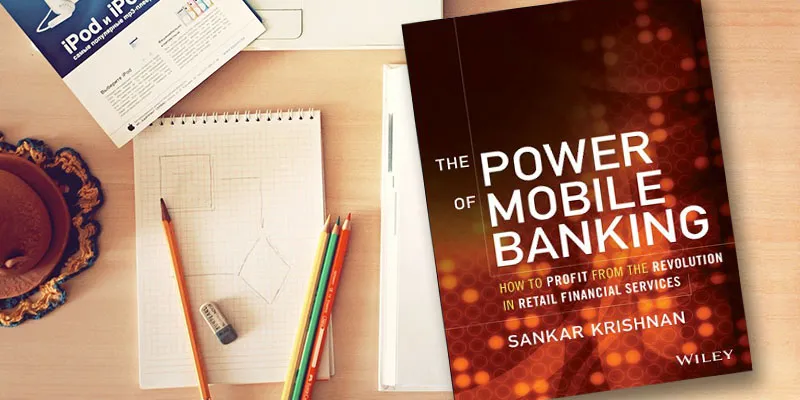12 success tips for startups in mobile payment and banking
The rapid adoption of mobile phones, their ease of use and multiple points of contact for transactions makes mobility a new opportunity for disruptive startups in mobile payments and banking. Incumbents such as banks and large players like telcos also need to become more nimble and agile in adapting to these new markets.
12 tips for success in mobile banking and payment are offered by Sankar Krishnan, Head of Banking Services, Americas at HCL, in his new book ‘The Power of Mobile Banking: How to Profit from the Revolution in Retail Financial Services.’

Today's tech-savvy consumers are demanding a more personal customer experience, and mobile services deliver individualized, tailored experiences better than any other technology, begins Krishnan in his 172-page book. Mobile Internet is creating a global community of highly empowered consumers. “Mobile can become a huge driver of profit, for businesses large and small, all over the world,” he says, spelling out the landscape and roadmaps in eight chapters.
Here are my 12 key takeaways for startups and incumbents in the field of mobile payment and banking.
1. Understand the mobile phenomenon
Mobile subscriptions outnumber fixed lines, and mobile broadband outnumbers fixed broadband. But online (Internet) strategy should not be confused with mobile strategy – they are different and require radically different approaches, cautions Krishnan. Mobiles are driving the “biggest economic revolution we will see in our lifetimes,” says Farhad Irani, EVP at Mashreq Bank.
2. Understand the behaviour transformation
Mobile is not just a technological phenomenon but psychological and sociological too. The old shopping paradigm of ‘touch and smell’ has been replaced by ‘see and hear.’ The idea of ‘doing something’ no longer requires ‘going somewhere’ thanks to mobile shopping. Mobiles have transformed every phase of traditional shopping – and opened up new individual and group channels of transaction services as well.
3. Map incumbents and disrupters
Banks, credit card companies, telcos, retailers, e-tailers, technology providers and startups constitute the spectrum of players in mobile payment. Tech providers created products like Quicken and MS Money. Telco moves in mobile payment include m-Pesa (Safaricom, Vodafone: Africa), Project Oscar (UK) and SMART Money (Philippines). Companies like eBay, Amazon and Apple operate like virtual banks, and a new mobile payment app seems to be launched by startups almost every day. Paypal, Moven, Simple and Green Dot are players to watch.
4. Ride and create the e-commerce wave
The growth of e-commerce holds the potential for new and profitable ways for consumer engagement. Pure-play mobile payment companies are entering the space, creating new products like mobile wallets even for the smallest routine purchases. Merchandise purchases, money transfers, pre-paid top-ups, travel ticketing and parking are typical use cases. Mobiles can extend the reach of credit cards and debit cards, or open up new ways of P2P payment and collective purchases. Cash and cheques are becoming less relevant in the e-commerce age.
5. The giant opportunity: mobiles in emerging markets
Some of the most powerful innovations in mobile services are happening in emerging economies such as Kenya, Philippines, China and India. “Growing up in Madras, India, in the 1980s, I saw firsthand the impact of the digital revolution on one of the world’s largest and most populous nations,” recalls Krishnan.
“By 2018, 40-50 percent of all mobiles in Africa may have access to the Internet,” says Steven Livingstone of the Africa Centre for Strategic Studies. Most poor households in emerging economies operate entirely with cash; 2.5 billion people worldwide have no financial accounts, according to the World Bank. One-fifth of U.S. adults are unbanked or under-banked.
Mobile is well suited to offer new payment and banking options for consumers at the bottom of the pyramid (BoP). The social enterprise GiveDirect blends sampling techniques, home visits and mobile technology to deliver loans and donations to poor people.
6. The youth opportunity: products and services for digital natives
Youth can be regarded as Generation M – the generation that grew up with mobile phones and tablets (sometimes also called Generation Multitasking). Their comfort levels and buying behaviours are naturally tuned to the mobile era, as compared to tools like cheque books. They prefer using apps for transactions and services, well exemplified in the rise of cab services like Uber.
7. Open up your app store
Apps for payment and banking should offer not just information but transaction as well. Players will compete on the quality, usability, speed, security, convenience and appearance of apps. Apps should be designed with a customer strategy in advance, and specific pain points to address or conveniences to add. Apps should be used to discover more about consumer’s social habits and buying behaviours in real time. Open APIs have speeded up the innovation ecosystem for app developers, creating a LEGO mode for software and services.
8. The world-wide prepaid card market
“Don’t ignore the potential of pre-paid cards. They are widely used and accepted,” advises Krishnan. Open-loop and closed-loop pre-paid cards are a great opportunity for growth and market penetration, especially with regard to financial inclusion. New players in this space include NetSpend, AccountNow and MoneyGram.
9. Learn from mobile disruption in other sectors
Sectors like healthcare offer useful lessons in the power and capabilities of mobile. Transformations in the ‘health interface layer’ include trackable measures, education about healthy practices and apps to nudge behaviour in the right direction. Patient social networks such as ‘diabetes buddies’ improve ‘precision medicine’ and pro-active lifestyles. Virtual coaches help ‘patient self-management.’ Wearable devices from a range of startups are reinventing health practices and life sciences.
10. The dark side: manage risks
Along with opportunity, mobile payment opens up many risks: phishing, pharming, fraud, keylogging, identity theft, malware, privacy violations, operator vulnerabilities, integration challenges and complex supply chains. The tradeoff between security and convenience will always need to be balanced.
11. Transformation of banks
Banking leaders should overcome their conservative mindsets and ‘innovation blindness’ to convert their traditional retail branch banks into streamlined systems for mobile services. The challenge for banks is to run their current transaction business simultaneously with new mobile innovations to improve 24X7 multi-channel engagement and experience. This can include relevant marketing via use of Big Data to understand geo-spatial information. Mobile is a “wake up call” for banks to rely more on innovation and less on “pricing tricks and hidden fees.”
“Mobile banking is innovation incarnate,” says Krishnan. “To a certain extent, you will have to treat your mobile banking service as a startup,” he advises bankers, referring to incremental beta-testing rather than Big-Bang rollouts. One option for banks is to more actively engage with startups or acquire them to become more agile. “The key elements of agility are simplicity, pragmatism, iteration, adaptive planning, rapid response and adaptability,” explains IT expert Jim Tosone.
12. Keep an eye on the road ahead
In the years to come, mobile opportunities will come not just from phones and tablets but the Internet of Things (IoT): mobile-enabled watches, clothing, appliances, vehicles and ubiquitous sensors. Mobile is poised as an excellent opportunity in this new generation of smart business, ranging from in-app purchases to NFC channels. “Mobile is the new normal,” says Krishnan, it enables the creation of freedom, opportunity and empowerment.
“Once in place, a great mobile system delivers excellent service and benefits to users, as well as real value and unique features that cement customer loyalty,” says Krishnan. “Each step in the evolution of money has resulted in the creation of more wealth and generated more happiness for greater numbers of people,” he adds.
In sum, money has indeed come a long way from cowrie shells and salt tablets to currency and digital data! The book also has useful quotes from a range of finance and technology experts, and it would be good to end this review with a sample. (See also my pick of the Top 10 Books of 2014 for Entrepreneurs and the app ‘Proverbs and Quotes for Entrepreneurs: A World of Inspiration for Startups,’ accessible for Apple and Android devices.)
"Mobility, including geolocalization, opens a whole new spectrum of services.” - Ignacio Oviedo, former CIO at Banamex
“Mobile is transforming the pace, possibilities, and the way in which services are delivered and accessed.” - Rich Epstein, Chief Architect, Maersk Line
“Retail finance may be the next industry to get turned upside down by the mobile revolution that is sweeping the globe.” - Patrick Perrella, Director, University of Notre Dame
“The rise of the mobile device combined with the increased value of mobile business has made mobile the most important channel for the future of banking.” – Mick Simonelli, innovation consultant
“The pace of innovation in mobile technology is astonishing.” - Frank J. Casale, CEO, The Outsourcing Institute







